December
2021
December 1, 2021
From the Field
Median Income of Cultural Attendees by Ethnicity
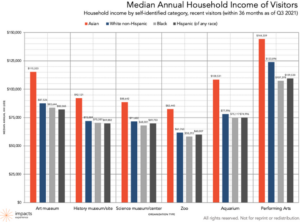 Colleen Dilenschneider of Impacts Experience has just published Median Income of Cultural Attendees by Ethnicity: Another Reason Not to Judge Visitors by Appearance. This analysis examines and disproves the pernicious assumption that racial diversity is consistent with income diversity among participants at cultural organizations. Instead, the data—which highlights the median income of attendees at different types of institutions—shows that, regardless of race or ethnicity, the average visitor has a higher median income than the average American. While large income inequality does exist and is pronounced along racial lines, arts and cultural organizations must be cognizant that fostering both economic and racial diversity among attendees requires distinct, targeted programming.
Colleen Dilenschneider of Impacts Experience has just published Median Income of Cultural Attendees by Ethnicity: Another Reason Not to Judge Visitors by Appearance. This analysis examines and disproves the pernicious assumption that racial diversity is consistent with income diversity among participants at cultural organizations. Instead, the data—which highlights the median income of attendees at different types of institutions—shows that, regardless of race or ethnicity, the average visitor has a higher median income than the average American. While large income inequality does exist and is pronounced along racial lines, arts and cultural organizations must be cognizant that fostering both economic and racial diversity among attendees requires distinct, targeted programming.
When Will Arts Attendance Return?
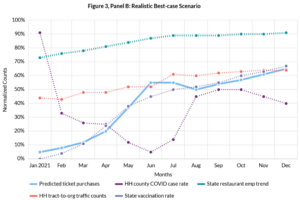 SMU DataArts’s new blog post, When Will Arts Attendance Return? uses historical ticket-sales data to model future ticket sales for performing arts organizations through the end of 2021. The scenarios, which compare ticket sales to the previous four-year high, all depend on varying levels of COVID-19 vaccination and changes in COVID-19 cases. The “realistic worst-case scenario” predicts ticket levels to reach 57% of the four-year record by December 2021, and the “realistic best-case scenario” predicts ticket sales reaching 65%. While the modeling is a prediction at best, it offers a powerful insight into the impact the COVID-19 pandemic has had on ticket sales and income generated for the arts and culture sector.
SMU DataArts’s new blog post, When Will Arts Attendance Return? uses historical ticket-sales data to model future ticket sales for performing arts organizations through the end of 2021. The scenarios, which compare ticket sales to the previous four-year high, all depend on varying levels of COVID-19 vaccination and changes in COVID-19 cases. The “realistic worst-case scenario” predicts ticket levels to reach 57% of the four-year record by December 2021, and the “realistic best-case scenario” predicts ticket sales reaching 65%. While the modeling is a prediction at best, it offers a powerful insight into the impact the COVID-19 pandemic has had on ticket sales and income generated for the arts and culture sector.
Culture + Community in a Time of Transformation
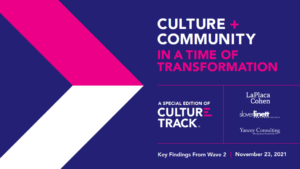 Culture Track, in collaboration with Slover Linett and Yancey Consulting, has just released Culture + Community in a Time of Transformation: A Special Edition of Cultural Track. This report—reflecting the second year of a national study examining audience behaviors, attitudes, motivations and barriers to cultural participation—focuses on previously underrepresented respondents and draws from nearly 80,000 survey respondents and 532 participating arts and culture organizations. Overall, the research outlines how Americans participated in arts during the COVID-19 pandemic, the demographics of who participated, and what role audiences believe arts and culture organizations have in equitable and social transformation.
Culture Track, in collaboration with Slover Linett and Yancey Consulting, has just released Culture + Community in a Time of Transformation: A Special Edition of Cultural Track. This report—reflecting the second year of a national study examining audience behaviors, attitudes, motivations and barriers to cultural participation—focuses on previously underrepresented respondents and draws from nearly 80,000 survey respondents and 532 participating arts and culture organizations. Overall, the research outlines how Americans participated in arts during the COVID-19 pandemic, the demographics of who participated, and what role audiences believe arts and culture organizations have in equitable and social transformation.
Museums and Trust 2021
In September, the American Alliance of Museums released Museums and Trust 2021, a report that covers how the U.S. population perceives museums. The survey was conducted in May 2021 and received 1,200 responses from a representative U.S. sample in terms of age, education, race and ethnicity. Analysis of the results concludes that the public continues to regard all types of museums as highly trustworthy—ranking only in second to friends and family and far above other U.S. institutions. Although trust varies slightly by race, the general pattern of trust holds true across all segments of race, political affiliation and attitudes. One of the reasons this pattern subsists is due to the nonpartisan nature of museums.
Reimagining Capacity Building: Navigating Culture, Systems & Power
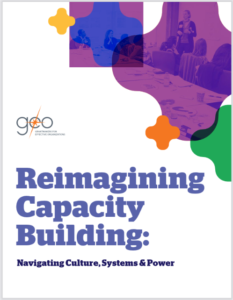 Grantmakers for Effective Organizations (GEO) explores how capacity-building practices can adopt more racial equity-centered approaches in its guide, Reimagining Capacity Building: Navigating Culture, Systems & Power. This publication revisits the core principles for supporting capacity building—contextual, continuous and collective action—outlined in its 2016 report Strengthening Nonprofit Capacity, and introduces the additional principles of being mission oriented, fostering trust and taking a systemwide perspective. Overall, GEO emphasizes that racially equitable capacity building requires an understanding of how power, culture and systems influence the practice of strengthening the organization.
Grantmakers for Effective Organizations (GEO) explores how capacity-building practices can adopt more racial equity-centered approaches in its guide, Reimagining Capacity Building: Navigating Culture, Systems & Power. This publication revisits the core principles for supporting capacity building—contextual, continuous and collective action—outlined in its 2016 report Strengthening Nonprofit Capacity, and introduces the additional principles of being mission oriented, fostering trust and taking a systemwide perspective. Overall, GEO emphasizes that racially equitable capacity building requires an understanding of how power, culture and systems influence the practice of strengthening the organization.
Mapping out Cultural Asset Mapping
Spire + Base, a consulting firm advising nonprofits in the development of creative placemaking strategies, produced Mapping Out Cultural Asset Mapping: A Practical Guide to the Practice. The publication’s working definition of cultural asset mapping is “Any process by which a community works to identify their arts and cultural assets, including people, places, events and/or real estate.” This guide illustrates and reflects upon the benefits and challenges of cultural asset mapping practices based on real-world observations from 62 experts in community arts, community development, government and academia. It introduces recommendations to employ cultural asset mapping in local revitalization efforts. The report was compiled with the support of ArtPlace America, and it served as a foundation for a training session for ArtPlace’s Community Development Investments program.
Investing in Rural Prosperity
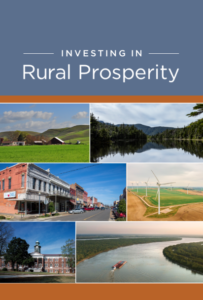 The Federal Reserve Bank of St. Louis has published Investing in Rural Prosperity, a collection of essays on rural policy and economic development from 79 authors. The collection seeks to help individuals and communities achieve shared economic prosperity, featuring the economic experiences of rural areas throughout the country and telling their stories of success. Although not the central focus of the essays, arts and culture—particularly creative placemaking and entrepreneurship—are credited multiple times as being an important part of the strategy in advancing rural development.
The Federal Reserve Bank of St. Louis has published Investing in Rural Prosperity, a collection of essays on rural policy and economic development from 79 authors. The collection seeks to help individuals and communities achieve shared economic prosperity, featuring the economic experiences of rural areas throughout the country and telling their stories of success. Although not the central focus of the essays, arts and culture—particularly creative placemaking and entrepreneurship—are credited multiple times as being an important part of the strategy in advancing rural development.
Foundations Respond to Crisis
 The Center for Effective Philanthropy (CEP) has just published Foundations Respond to Crisis: Lasting Change? as part of a series of reports on how the pandemic has changed the grant-making practices of foundations. CEP surveyed and interviewed nearly 300 foundation leaders during spring 2021. It discovered that grant makers plan on sustaining reduced administrative burdens for grantees, including fewer grant application and reporting requirements, increased unrestricted funding and new commitments toward racial equity.
The Center for Effective Philanthropy (CEP) has just published Foundations Respond to Crisis: Lasting Change? as part of a series of reports on how the pandemic has changed the grant-making practices of foundations. CEP surveyed and interviewed nearly 300 foundation leaders during spring 2021. It discovered that grant makers plan on sustaining reduced administrative burdens for grantees, including fewer grant application and reporting requirements, increased unrestricted funding and new commitments toward racial equity.
In this Issue
From the President and CEO
State to State
Legislative Update
The Research Digest
Announcements and Resources
More Notes from NASAA
SubscribeSubscribe
×
To receive information regarding updates to our newslettter. Please fill out the form below.
